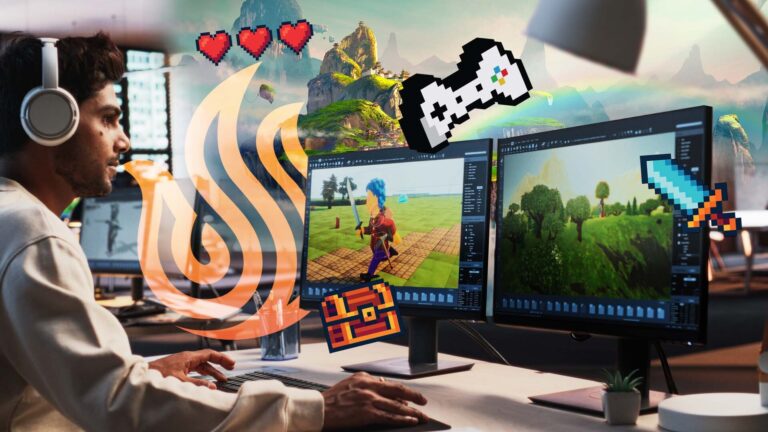Visual storytelling is more than just creating beautiful images—it’s about communicating ideas, emotions, and narratives through visuals. Whether it’s a film, animation, video game, or digital illustration, visual storytelling has the power to immerse audiences in ways that words alone often can’t. For those passionate about visual media, understanding the core of visual storytelling may lead to a range of creative opportunities.
This blog will explore what visual storytelling is, how it’s applied across different mediums, and why a strong foundation in this skill is important. We’ll also explore how it appears in video games, films, virtual reality, advertising, graphic novels, and other digital experiences, as well as educational opportunities like the Digital Art & Animation program at the University of Silicon Valley.
What Is Visual Storytelling?
At its core, visual storytelling is the art of conveying a narrative using visual elements. These can include characters, color, composition, lighting, movement, and environment. It often works in tandem with text, sound, or dialogue, but it can also stand alone.
Visual storytelling can be found in many creative industries:
- Animated films and series
- Graphic novels and comic books
- Video games
- Virtual reality experiences
- Advertising and branding
- Digital art and illustration
- Photography
- Motion design and interactive media
The aim is to engage the viewer and evoke a response, whether that be curiosity, empathy, or excitement.
The Building Blocks of Visual Storytelling
Before any visual can take shape, many projects begin with a written narrative or concept. Whether it’s a script, a scene breakdown, or a creative brief, visual storytellers often interpret and expand on written material to bring stories to life visually. This translation from text to image is a key part of the process.
Composition
How elements are arranged within the frame affects how the story is perceived. Balance, perspective, and focal points guide the viewer’s eye and can highlight emotions or actions.
Lighting and Color
Lighting sets the tone of a scene, while color can create mood, symbolize ideas, and differentiate characters or environments. Think of how warm lighting can make a space feel comforting, while stark lighting might feel intense or unsettling.
Character Design
Characters are often the heart of the story. Their design—from posture and facial expressions to costume and proportions—helps communicate personality and backstory without the need for words.
Environment and Setting
Where the story takes place matters. Backgrounds and settings can hint at time period, culture, and even mood. A ruined cityscape, for instance, tells a very different story from a vibrant futuristic metropolis.
Visual Storytelling Across Mediums
Animation
Animation relies heavily on visual storytelling. Characters express emotion through movement. Environments are crafted to support the narrative. Everything on screen is intentional, and each frame contributes to the story. Understanding the animation pipeline is essential for aspiring animators. It involves stages such as concept development, storyboarding, modeling, rigging, animation, rendering, and post-production. Each phase requires a unique visual approach to ensure narrative consistency.
Video Games
Storytelling in video games is interactive. Players often become part of the story, making decisions that influence the narrative. Visual cues such as environment design, character animations, and UI elements all contribute to guiding the player and enhancing immersion. Visual storytelling in games often must be flexible and dynamic, especially in open-world or choice-driven formats.
Digital Art and Illustration
Still images can tell stories, too. From concept art to comic panels, visual artists use perspective, lighting, and symbolism to craft compelling narratives within a single frame. A strong piece of digital art can capture a moment so powerfully that it suggests a much larger story.
Graphic Design and Advertising
In marketing and branding, visual storytelling helps companies communicate their values and engage audiences. Logos, social media campaigns, packaging, and promotional videos all rely on visual elements to connect with viewers quickly and memorably.
Photography and Cinematography
A single photograph can hold an entire narrative—emotion, tension, context, and character. Cinematography takes this further, where lighting, angles, and movement within a scene shape how stories unfold in films and video content.
Virtual and Augmented Reality
Immersive technologies use visual storytelling to create engaging, interactive narratives. In VR or AR, users explore stories spatially, and design choices guide how narratives are experienced in real-time.
Why Visual Storytelling Matters
Visual storytelling helps creators:
- Communicate more efficiently: A well-designed image can convey complex information quickly.
- Connect emotionally: Visuals often evoke stronger emotions than text alone.
- Increase engagement: Stories told through visuals are more likely to captivate audiences.
Whether you’re an aspiring animator, concept artist, or game designer, these skills could be considered essential in the creative process.
How to Learn Visual Storytelling
Some people explore visual storytelling through self-teaching—experimenting with software, studying online tutorials, or learning through trial and error. While that path can build certain skills, a structured education is often developed and led by professionals with real-world experience. These programs can provide context, feedback, and exposure to industry-relevant workflows that may be harder to access independently.
The Digital Art & Animation program at the University of Silicon Valley includes courses that aim to explore these visual principles in-depth. While no program can guarantee outcomes, students could develop valuable skills such as:
- Storyboarding and narrative development
- Character and environment design
- 2D and 3D animation techniques
- Conceptual art workflows
- Understanding of the animation production pipeline
Learning in a creative community also helps you understand how different roles—from concept artists to animators and technical directors—collaborate to bring stories to life.
Practical Examples of Visual Storytelling
Pixar Films
Every Pixar movie is an example of masterful visual storytelling. For example, in Up, the “Married Life” montage tells a complete emotional story without a single line of dialogue.
The Legend of Zelda Series
In these games, environmental clues, character design, and symbolic imagery all contribute to narrative progression. Players explore, uncover backstory, and make decisions that drive the plot forward.
Graphic Novels Like Saga or Persepolis
These works combine illustration and text, but rely heavily on visuals to set tone, show action, and convey subtext.
National Geographic Photography
Photojournalism is a form of visual storytelling that documents real-life events, often sparking global awareness and emotional responses with a single powerful image.
Augmented Reality Art Installations
Interactive AR installations allow viewers to experience stories in public or digital spaces, adding layers of narrative to physical environments.
Common Challenges and How to Overcome Them
Telling Without Over-Telling
Sometimes visuals can be too literal or too ambiguous. The key is finding the right balance: showing just enough for the viewer to understand while leaving room for imagination.
Consistency Across Mediums
In animation or game development, ensuring consistency in lighting, color palettes, and character design is vital. This is where understanding the animation pipeline or art direction becomes crucial.
Staying Technically Proficient
Software tools evolve quickly. Staying up to date with programs like Adobe Creative Suite, Maya, or Blender can help support your storytelling with strong technical execution.
Frequently Asked Questions (FAQ)
Is visual storytelling only for animators?
No. While animators use it heavily, visual storytelling applies to many fields including illustration, photography, graphic design, and game development.
Do I need to be good at drawing?
Not necessarily. Many aspects of visual storytelling involve design thinking, cinematography, or editing. While drawing helps, other skills like composition and storytelling intuition are equally important.
How does visual storytelling differ in video games?
Video games often require interactive storytelling. The player becomes part of the narrative, so visual cues are used not only to convey story but also to guide gameplay.
What is the animation pipeline?
It’s the step-by-step process involved in producing an animated project. It includes concept, storyboarding, modeling, rigging, animation, lighting, rendering, and compositing. Each stage involves its own storytelling techniques.
Can I learn visual storytelling at USV?
Yes, the Digital Art & Animation program at the University of Silicon Valley explores this topic through hands-on courses and collaborative projects, helping students explore how visuals and narrative work together across media.
Final Thoughts
Visual storytelling is a dynamic, essential skill across creative industries. From animation to video games, from illustration to design, the ability to communicate effectively through visuals is becoming more and more valuable. Learning how to craft compelling stories visually isn’t just about artistic talent—it’s about observation, practice, and collaboration.
For those interested in diving deeper into the craft, the Digital Art & Animation program at the University of Silicon Valley offers students a chance to explore visual storytelling within a collaborative learning environment. Whether you’re sketching your first characters or ready to animate full scenes, the journey of visual storytelling starts with understanding how visuals can move people.


